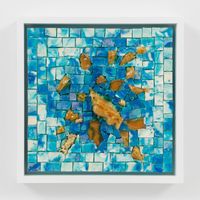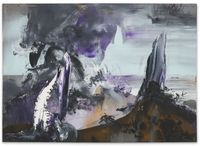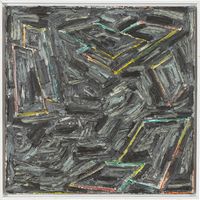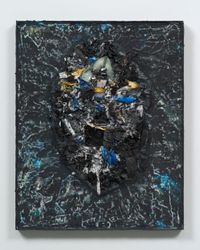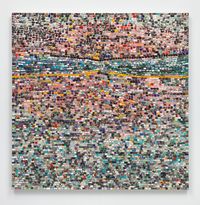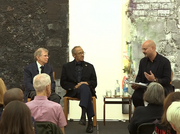Jack Whitten was a painter and sculptor known for his innovative manipulations of acrylic paint and explorations of materials not commonly found in art. Combining his interests in materiality, light, artistic traditions, Black figures and socio-political events, Whitten pushed at the boundaries of form and human perception.
Read MoreBorn in 1939 in Bessemer, Alabama, Whitten grew up in the segregated South and was a teenager when the civil rights movement was gaining momentum in the United States. In 1959, he enrolled in Tuskegee Institute, Alabama, before transferring to Southern University in Baton Rouge, Louisiana, a year later. Although Whitten believed in the principles of nonviolence preached by Martin Luther King Jr, whom he had heard speak in Birmingham in 1957, he decided to leave the protests and the South after experiencing white hostility during a civil rights march in 1960. He moved to New York, where he was mentored by abstract expressionist artists Norman Lewis and Willem de Kooning. As a result, Whitten's early paintings from the 1960s show abstract expressionist influences; in NY Battle Ground (1967), for instance, clouds of black paint and colourful spots seem to be exploding from a volcano-like pink shape at the centre of the canvas. During this period, Whitten also began to develop an interest in process-oriented art.
In 1970, Whitten was invited to Rochester, New York by the Xerox Corporation to experiment with its equipment, where he invented a signature method of layering acrylic paint on a pre-existing image and dragging a squeegee, an afro comb or a rake-like tool across its wet surface. Pink Psyche Queen (1973) exemplifies the blurring effect created by the combing process, which exposes parts of the drawing underneath the acrylic coating. In the later 'Greek Alphabets' series (1976–1979), the effect becomes more distinctive, with lines made visible by using pieces of wire and thin metal sheets. Because this method revealed or 'developed' the previously established image below, Whitten likened it to the photographic process in which his squeegees and raking tools functioned as developers. He also nicknamed the artworks created in this fashion 'slab paintings', referring to the thickness of the acrylic coating that ranged from ¼ to ⅜ of an inch.
In the following decades, Whitten devised another signature method of casting acrylic paint into small units that could be organised into mosaics. Described by the artist as the 'tesserae'—a term borrowed from Mediterranean mosaics—these acrylic units represent the fusion of gesture and process of painting and are abstract painting's equivalent of the byte (a unit of digital information). His 'Black Monoliths' paintings—a series begun in 1986—are dedicated to influential Black figures such as James Baldwin, Ralph Ellison and Jacob Lawrence, and attempt to encapsulate their essence or soul through abstraction. Works like Black Monolith X (Birth of Muhammad Ali) (2016) demonstrate Whitten's fluid use of the acrylic tiles. In the painting, the tesserae are cut into irregular shapes and oriented in irregular directions to embody the legendary boxer's energy, whose performance Whitten saw live once. Whitten's works also respond to current events such as in 9.11.01 (2006), which captures the 9/11 terrorist attack that he witnessed from his studio in New York. Positioned at slight angles, the tesserae absorb and reflect light from multiple directions, resulting in a dynamic and luminescent effect.
Throughout his career, Whitten gained a reputation for his repeated experimentation with materials both new to him and the art world. The paintings his in 'Quantum Walls' series (2016—2017), titled after the artist's interest in quantum mechanics, all deploy Pyrisma—an innovative mica-based pigment—as the basis for their tesserae. Pyrisma mimics phosphorescence in nature and shifts colours under different kinds of light. The colours of Quantum Wall (The Geometry of Being an Octopus) (2016), for example, range from varying shades of violet to black. The painting alludes to Whitten's fascination with the octopus' ability to shift colours to blend into its surrounding environments. For The Third Entity #10 (2016)—from the series of drawings titled 'The Third Entity'—Whitten used black graphite and Renaissance wax on a synthetic paper known as Evolon, experimenting with the material to achieve a somewhat photographic result.
Drawing from both African and European traditions, Whitten's sculptures offer a new definition of American culture with Black identity at its core. Quantum Man (The Sixth Portal) (2016), for instance, is a vertical form consisting of blocks of Cretan walnut, Serbian oak, Greek marble and the internal parts of various electronics as well as handcrafted metals from a local blacksmith in Crete. This multimedia sculpture references nkisi or African power figures, which are believed to have protective powers in west-central African lore. By merging the traditions and spiritual association of African sculptures with materials of Western origin, Whitten asserts Blackness as inextricable from Western culture. As deeply personal creations carved in the Greek island of Crete, where the artist spent summers for more than four decades, Whitten's sculptural works were less frequently shown than his paintings. Before he passed away in January 2018, however, he collaborated with the Baltimore Museum of Art to organise Odyssey: Jack Whitten Sculpture 1963–2016 (22 April–29 July 2018), a survey focused on 40 never-before-exhibited sculptures.
Selected solo exhibition of Whitten's work include More Dimensions Than You Know: Jack Whitten, 1979–1989, Hauser & Wirth, London (2017); Jack Whitten: The Sixties, Allan Stone Projects, New York (2016); and Jack Whitten, Alexander Gray Associates, New York (2015). In 2014 the Museum of Contemporary Art San Diego organised a major retrospective of his oeuvre, titled Jack Whitten: Five Decades of Painting, which travelled to the Wexner Center for the Arts, Columbus; the Walker Art Center, Minneapolis; and Zeno X Gallery, Antwerp in the following year.
Sherry Paik | Ocula | 2018
